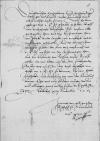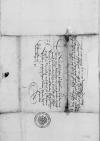Dem durchlauchten, hochgebornen fursten und herren, hern ⌊Albrechten⌋, von Gots gnaden marggraff zu ⌊Brandenburg⌋, / in ⌊Preussen⌋, zu ⌊Stetin⌋, ⌊Pomern⌋, / der ⌊Cassuben⌋ und ⌊Wenden⌋ hertzog, / burggraff zu ⌊Normberg⌋ / und furst zu ⌊Rugenn⌋, / unserm hochgunstigen, lieben herren unnd freunde
Durchlauchter, hochgeborner furst, hochgunstigerr, lieber her und freundt. / Unsere freuntliche unnd vleiss willige dinste zuvorn. /
Wir habenn gestrigs tags Ewer Furstlichen Durchlaucht ⌊⌋ erhalten, / doruff wir unbeschwert ⌊koniglicher maiestet⌋, / unserm aller gnedigisten hern, / und dem hochwirdigen ⌊hern von Plotzka⌋ / under cantzler, / wie eingelegte ⌊⌋ mitbringen, geschrieben, / auch des betrieglichenn gewants halben / der form und weiss nach, / wie Ewer Furstliche Durchlaucht anzeigt, / an den ⌊hochwirdigen hern⌋ / und die ⌊ersamen von Breslaw⌋ / unser brieffe geben, / die wir bitten mit den iren zuubersenden. / Es sein uns auch im dato diese beigelegte von hoffe an Ewer Furstlichen Durchlaucht zukommen, / die wir hiebei zuschicken / mit erbietung, wo wir der freuntlich dienen, / ehre und nutz furdern mugen, / vordan und allwegen gantz willig zusein und geflissen. /
Datum ⌊Heilsberg⌋, XVI Novembris 1541. /
⌊Ioannes⌋, von Gots gnaden bischoff zu ⌊Ermelandt⌋ /
manu propria subscripsit


